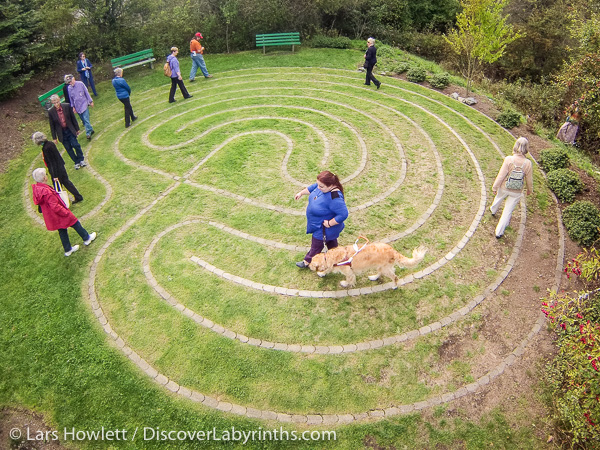Labyrinths create time and space to reconnect with your self, environment, and community. With the stress and uncertainty of our day and age, many are turning to this ancient archetype in search of peace, healing and transformation. Individuals and groups use labyrinths to practice mindfulness, navigate life transitions, honor big events, cultivate peace and hear their own inner wisdom. Found in public parks, schools, hospitals, churches, and backyards, labyrinths offer a metaphorical journey for people from all walks of life.
The labyrinth at Chartres Cathedral in France covered with chairs.
The 7-Circuit Classical Labyrinth is one of the oldest and most common patterns-- a tablet from Pylos, Greece has been dated to 1200 BCE. The greatest number of surviving walkable labyrinths can be found in Sweden, where hundreds created with field stones line the coast of the Baltic Sea. Woven into baskets in the American Southwest, the Man in the Maze reflects the Classical Labyrinth and Cretan coins from 400 BCE also featured design variations.
The labyrinth at Grace Cathedral in San Francisco, California.
Other historic designs include the Baltic Wheel (with a separate entrance and exit), the Chakravyuha (with a spiral center), Roman Labyrinths (often square shaped), and English Turf Mazes (the largest surviving design located at Saffron Walden). Contemporary labyrinths draw upon old forms, exploring variations or experimenting with new patterns to reflect modern themes and settings. Labyrinths can be as short as 3-Circuits or as long as 15-Circuits or more. Portable labyrinths can be offered on canvas for walking or paper for tracing by finger.
Classical Labyrinth at a hospital on Vancouver Island, Canada.
The history of labyrinths is both mystical and mysterious. Mythologically, labyrinths refer to networks of perplexing passageways popularized by the tale of Theseus and the Minotaur. Today, for greater clarity, labyrinths are defined as having a single pathway that meanders toward a center. Unlike a maze, there are no dead ends, and instead of walls, the path of the labyrinth is laid out flat on the ground with the design and destination in full view from the entrance.
The labyrinth at Frojel on the island of Gotland in the Baltic Sea.
The 11-Circuit Medieval Labyrinth at the Chartres Cathedral in France is a widely replicated pattern. In 1201 AD the labyrinth was inlaid in the stone floor of the nave following the principles of sacred geometry with a symbolic center rosette and perimeter lunations. Lauren Artress brought this design to Grace Cathedral in 1994 and it is now permanently installed in stone both indoors and out, inspiring thousands of others to build labyrinths of their own.
The Labyrinth of Wisdom at Sophia University by Robert Ferre and Lars Howlett.




